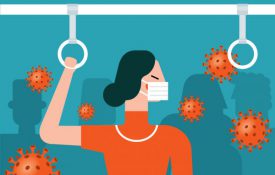-
A Vast Right Arm Conspiracy? Study Suggests Handedness May Effect Body Perception
There are areas in the brain devoted to our arms, legs, and various parts of our bodies. The way these areas are distributed throughout the brain are known as “body maps” and there are some significant differences in these maps between left- and right-handed people. For example, in left-handed people, there is an equal amount of brain area devoted to the left and right arms in both hemispheres. However, for right-handed people, there is more cortical area associated with right arm than the left. Psychologists Sally A. Linkenauger, Jonathan Z. Bakdash, and Dennis R. Proffitt of the University of Virginia, along with Jessica K. Witt from Purdue University, and Jeanine K.
-

Sneezing in Times of a Flu Pandemic: Exposure to Public Sneezing Increases Fears of Unrelated Risks
The swine flu (H1N1) pandemic has received extensive media coverage this year. The World Health Organization, in addition to providing frequent updates about cases of infection and death tolls, recommends hyper vigilance in daily hygiene
-
Angry Faces: Research Suggests Link Between Facial Structure and Aggression
Angry words and gestures are not the only way to get a sense of how temperamental a person is. According to new findings in Psychological Science, a journal of the Association for Psychological Science, a quick glance at someone’s facial structure may be enough for us to predict their tendency towards aggression. Facial width-to-height ratio (WHR) is determined by measuring the distance between the right and left cheeks and the distance from the upper lip to the mid-brow. During childhood, boys and girls have similar facial structures, but during puberty, males develop a greater WHR than females.
-
Study Maps Social Proximity to Temperature
Adding to the emerging literature on “embodied cognition,” a new study looks at metaphors, like “the cold shoulder” and “warm feelings,” to test the link between thermometer readings and feelings of closeness or distance, affection or iciness. Utrecht University psychologists Hans IJzerman and Gun Semin conducted a series of experiements designed to look at the connection of our bodily sensations are inextricably bound up with emotions like hatred and desire. In the first experiment, volunteers who had just arrived in the lab were asked to hold the experimenter’s beverage for a few minutes, ostensibly so he could do something that required two hands.
-
Where’s the Science? The Sorry State of Psychotherapy
The prevalence of mental health disorders in this country has nearly doubled in the past 20 years. Who is treating all of these patients? Clinical psychologists and therapists are charged with the task, but many are falling short by using methods that are out of date and lack scientific rigor. This is in part because many of the training programs — especially some Doctorate of Psychology (PsyD) programs and for-profit training centers — are not grounded in science.
-
Making Sense of Ambiguous Faces
We all use stereotypes every day, whether we like it or not. It’s how we sort an impossibly complex world into manageable categories: man, woman, Italian, Chinese, lawyer, engineer. Stereotypes can be unfair and hurtful to many people, but the power of stereotyping is undeniable. But what exactly is going on in the mind when we stereotype someone? Is the process instantaneous and automatic, or do we deliberate over traits and categories before making judgments?

